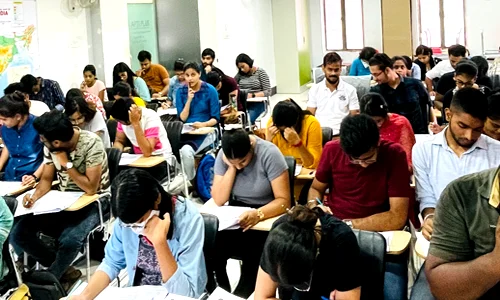



First Indian study measuring inhalable microplastics at breathing height across four metros shows plastics now form up to 5% of urban particulate pollution. Markets in Kolkata and Delhi show highest loads. iMPs carry pathogens, heavy metals and toxic chemicals, posing emerging health risks including inflammation, hormonal disruption and possible cancer pathways. Urgent inclusion of microplastics in air-quality regulation is needed.
Click to View MoreParticulate Matter, especially the ultrafine PM1 fraction, has emerged as a major public-health concern in India due to its ability to penetrate deep into the lungs, enter the bloodstream and carry highly toxic metals and reactive chemicals. Studies show PM1 is more harmful than PM2.5, yet it remains unmonitored in India’s regulatory framework, creating a significant data and policy blind spot. Research from Delhi reveals PM1 is often underestimated by nearly 20%, masking true exposure levels during severe pollution episodes. The implications are extensive—rising cardiovascular and child-health risks, high indoor infiltration, delayed policy action, and strong climate linkages through black carbon. While India has launched multiple initiatives such as NCAP, GRAP, BS-VI norms, PMUY and stubble-management schemes to curb PM pollution, the absence of PM1 standards limits their effectiveness. Integrating PM1 into national monitoring, regulation and health studies is now essential for comprehensive air-quality governance.
Click to View MoreChina cleaned its air through strict central planning, the 2013 action plan, industrial controls, and rapid EV adoption backed by bureaucratic accountability. India needs similar long-term, well-funded, multi-sector action instead of reactive steps like GRAP to tackle its persistent pollution and achieve sustained air-quality gains.
Click to View MoreAir pollution is a critical environmental and public health issue, contributing to respiratory illnesses, child mortality, and climate change. Major sources include industrial emissions, vehicular pollution, coal dependence, and crop residue burning. Weak enforcement of environmental regulations and rapid urbanization exacerbate the problem. Case studies from India and globally show that integrated policies, clean energy adoption, sustainable agricultural practices, and strict regulatory measures can help reverse the trend, improving air quality and public health.
Click to View MoreAir pollution in India significantly impacts children’s growth, leading to stunted physical development, respiratory problems, and cognitive impairments. Studies from Delhi-NCR, Punjab, and Vidarbha show that prolonged exposure to fine particulate matter and toxic air pollutants reduces height and lung capacity in children under five. Effective government measures and community-level interventions are crucial to protect children’s health and ensure equitable development.
Click to View MorePesticide pollution in India is a growing environmental and public health concern. Overuse of chemical pesticides, especially in cotton and high-value crops, contaminates air, water, and soil, affecting both farmers and nearby communities. Regulatory gaps, limited monitoring, and lack of awareness exacerbate the problem. Integrated pest management, bio-pesticides, safer spraying practices, and stronger enforcement of laws offer viable solutions. Case studies from Telangana, Maharashtra, and Punjab show that reducing chemical dependency is possible without affecting crop yields, promoting healthier, sustainable, and inclusive agriculture.
Click to View MoreStubble burning in India has multidimensional consequences. Environmentally, it releases particulate matter and greenhouse gases, reduces soil fertility, and harms biodiversity. Health-wise, it causes respiratory and cardiovascular diseases, eye irritation, and skin problems. Economically, while it saves farmers time and labor in the short term, it degrades soil, reduces crop yields, raises healthcare costs, and affects transport and tourism. Socially, it can trigger public health crises, farmer migration, and conflicts over legal penalties. Effective policy measures—including satellite monitoring, incentives for eco-friendly machinery, and balancing farmer livelihoods with environmental protection—are crucial to mitigate these impacts.
Click to View MoreShort-term exposure to PM2.5, especially from landscape fires and urban pollution, significantly increases hospital admissions among children and adolescents for respiratory, infectious, cardiovascular, neurological, digestive, and other illnesses. Children aged 5–9 years and those from lower socioeconomic backgrounds are particularly vulnerable.
India has implemented measures like the National Clean Air Programme (NCAP), Pradhan Mantri Ujjwala Yojana (PMUY), air quality monitoring, and crop residue management to reduce PM2.5 exposure. However, challenges persist due to high ambient pollution, indoor smoke, socioeconomic disparities, and gaps in awareness.
A multi-pronged approach involving regulation, clean energy adoption, indoor air quality improvement, public awareness, and child-specific protective measures is essential to safeguard children’s health and reduce the long-term impacts of air pollution.
Click to View More
As Delhi battles severe air pollution, IIT Kanpur’s cloud seeding plan offers short-term relief by dispersing silver iodide into clouds to trigger rain that clears pollutants. However, its effectiveness depends on weather, and concerns over cost, feasibility, and environmental impact demand long-term pollution control measures.
Click to View MoreIndia’s air and noise pollution monitoring systems face challenges like poorly placed sensors, data inaccuracies, and limited real-time noise data. While air quality monitoring has improved with real-time stations and the National Clean Air Programme, noise pollution lacks a strong national policy and effective enforcement. To protect public health and meet global standards, India must expand monitoring coverage, ensure data transparency through independent audits, align regulations with WHO guidelines, and integrate advanced technologies for better forecasting and action.
Click to View MoreGreen crackers are eco-friendly alternatives to traditional firecrackers, designed to reduce air and noise pollution. They produce lower emissions of harmful gases and particulate matter, helping protect public health and the environment. Governments promote their use during festivals to balance cultural celebrations with environmental and health concerns.
Click to View More
© 2025 iasgyan. All right reserved